Recent Projects
Analysis of Steel-Concrete Composite Shell Structures
Steel-concrete (SC) composite elements consist of a thick concrete core section sandwiched between thin steel faceplates. The element core typically contains no conventional reinforcement, but utilizes shear studs and cross-tie bars to join the core to the faceplates, and to serve as transverse shear reinforcement. In the past, there had been considerable interest in the use of SC systems for the construction of nuclear power plant structures due to the significant cost savings which could be attained as a result of employing modular SC systems. Today, the increasing need for design of seismic and impact resistant structures has led to renewed interest in the development of SC composites. Further development of the software program VecTor4, a nonlinear finite element analysis program for reinforced concrete shell structures, focused on incorporating SC analysis capabilities is currently underway. The resulting analysis procedure will be used to perform a preliminary assessment regarding the behaviour of SC composite shell elements under seismic loading conditions, a research area not previously investigated. The capability of SC elements to achieve desirable ductility levels, specifically under three-dimensional shear critical loading conditions, will be investigated.

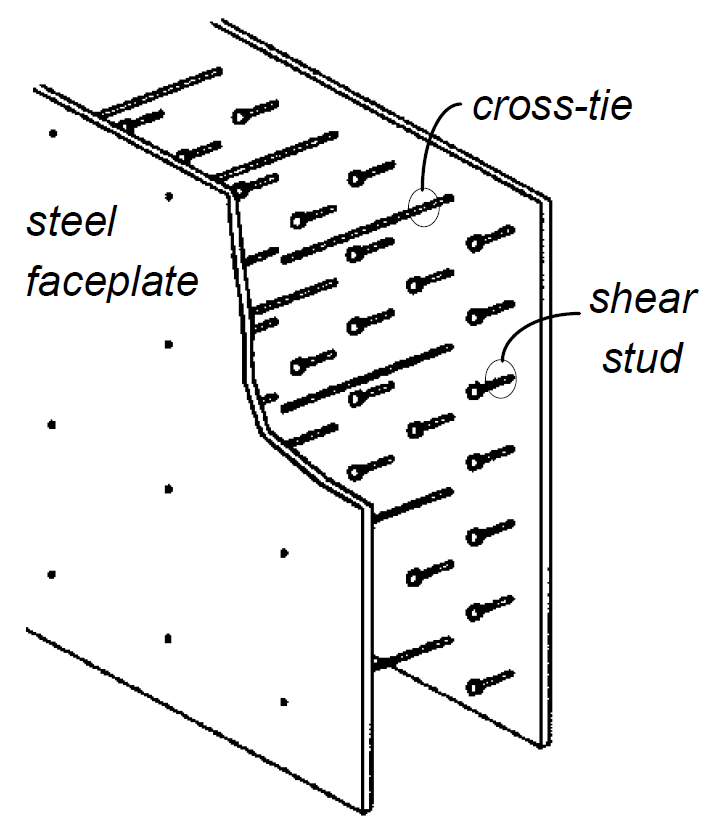
Steel-Concrete (SC) Composite Element
(adapted from Usami et al., 1995)
Analysis of Mixed-Type Structures
The current suite of VecTor analysis programs were developed such that each program is capable of modeling one particular type of structure only. However, there are many applications in which different types of structural components act together. A master program is being developed to account for the interactions between substructures and enable the analysis of mixed-type structures using the VecTor computational methodologies and material model formulations. The concept is to compute displacements at master points which are shared between two or more substructures; based on the computed displacement at each of these principal points, analyses would be performed for each substructure using appropriate VecTor program. This allows the use of parallel processing which results in faster and more efficient analysis.
In addition, work is being done to make the VecTor programs compatible with hybrid simulation tests. Hybrid simulation testing requires the use of a continuous feedback system between the physical model and the numerical model, often in real-time. Enabling the use of the VecTor programs as the numerical model will result in more accurate simulations of the complex nonlinear behaviour of concrete structural elements and, thus, more accurate hybrid simulations.

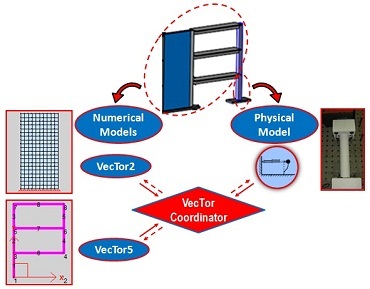
Mixed-Type Analysis
Development of Simplified Analytical Tools for Impact and Impulsive Loading Analysis of Reinforced, Prestressed and Steel-Composite Concrete Slabs
Current methods used for analysis of reinforced concrete (RC) structures under impact loading are mainly based on single degree of freedom (SDOF) methods or complex hydrocodes. Most SDOF methods tend to simplify the behavior of the structure, and cannot deliver results in required detail. While, hydrocodes overcome the problems caused by simplification of the behavior, they require a large number of material inputs and modelling of the structure in high detail. The goal of this research is to develop a simplified analytical tool to analyze reinforced concrete slabs under impulsive loading particularly soft and hard missile impacts. The VecTor programs, developed at the University of Toronto, are nonlinear finite element analysis programs for RC structures. These programs are capable of the analysis of shear critical structures accurately using less degrees of freedom than typically required by a hydrocode. This study focusses on improvement of VecTor programs to increase their capability and performance to handle missile impact analyses, where localized severe shear failure is observed.

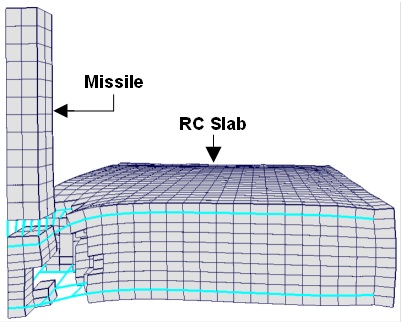
Hard missile impact analysis in VecTor3
(Quarter of the slab is modeled due to symmetry)
Improved Analysis and Design of Wind Turbine Foundations
The susceptibility of constituent materials of a wind turbine foundation (especially reinforcing steel) to fracture under cyclic loading is high, when induced dynamic stresses as a result of wind or waves in the foundation are not properly mitigated in design.
Over the years, the norm in wind turbine foundation design against fatigue considers the material provision to be adequate when the design life cycle is lower than the number of cycles leading to failure at a given stress level. This approach is acceptable for reinforced concrete elements in flexure, as long as bond fatigue does not govern. Hence, the S-N curves and damage models developed for concrete and steel reinforcing bars are sufficient in predicting fatigue failure of beams governed by flexure. However, the behaviour of stirrups under shear fatigue is by far more complex and requires a thorough approach. As such, available S-N curves and damage models may not give appropriate predictions if salient mechanisms in shear fatigue are not taken into consideration.
Generally, increased volume of materials are provided to reduce the materials stresses until the corresponding number of cycles to failure increases beyond the design service life cycles. However, some obvious flaws in increasing the amount of stirrups exist. These include: congestion of reinforcement, excess construction time, and poor foundation concreting. In addition, under shear fatigue, the influence of embedded stirrups on the diagonal crack initiation is insignificant. Previous research has shown that fatigue damage accumulation of stirrups begin after diagonal crack. Thereafter, fracture of the stirrups or longitudinal reinforcing bars at intersections with diagonal crack may occur and result in the collapse of the structure. Based on these, an appropriate means of extending the number of cycles at which these cracks occur is deemed crucial.
Research on steel fibre has shown its effectiveness in flexure and tension under monotonic loading, impact loading and fatigue resistance in flexure. As such, it is paramount that its influence on shear fatigue diagonal crack is investigated. Further, developments of models which adequately predict reinforced concrete elements responses under constant and variable fatigue load are invaluable. The extension of such models to include the influence of steel fibre is also vital.
Currently, the behaviour of steel fibre in enhancing shear fatigue resistance of beams is being investigated in order to improve the analysis and design of wind turbine foundations. Tests on plain and steel fibre reinforced concrete specimens are to be conducted under tensile and compressive fatigue loads in order to develop materials damage models. The models to be developed are also to be corroborated with the behaviour of two large scale wind turbine foundations to be tested under fatigue loading.

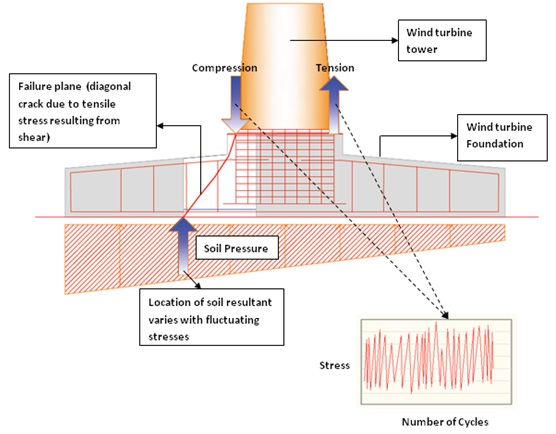
Behaviour of Ultra-High Performance Fibre Reinforced Concrete (UHPFRC) and Hybrid Steel Fibre Reinforced Concrete (HySFRC)
UHPFRC is a new generation material typically containing short steel microfibers with volume ratios of up to 5%. Its outstanding material characteristics include self-consolidating workability, high compressive strengths, high tensile strengths, a strain-hardening post-cracking response, and excellent crack control properties. The high tensile strengths makes it possible, in some cases, to significantly reduce or eliminate conventional reinforcement, reducing congestion and allowing for thinner and more economical sections. These attributes make it advantageous in high-performance applications such as offshore platforms and nuclear power plant buildings, bridge decks, and blast and impact resistant structures. HySFRC contains high strength steel micro- and macro- fibres in effective ratios so as its behavior to be superior compared to the use of a single type of fibre, with no other modifications in the matrix mix. This characteristic is attributed to the synergistic effect of the fibre cocktails.
For both materials the research is driven towards the behavior in shear under monotonic and cyclic loading. Our ability in effectively designing the structures above rides on the development of appropriate constitutive models for the characterization of the novel cracked composite. To more clearly isolate and study the shear behaviour, a series of panel specimens will be tested using the Panel Element Tester facility. The models to be developed will be implemented to facilitate use in the VecTor 2 Finite Element analysis program.

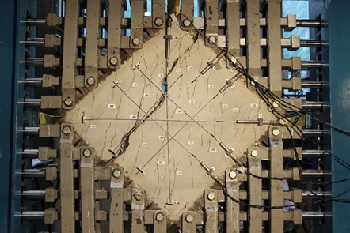
HybSFRC under monotonic shear loading after failure
Stochastic Nonlinear Finite Element Analysis of Reinforced Concrete Structures
Increasing fiscal limitations to maintenance budgets in recent decades mean that Canadian infrastructure now faces an urgent need to reliably predict the safety of deteriorating structures. The analysis of a deteriorating structure can be a challenging task for a structural engineer. Deterioration effects may not be immediately apparent, they are difficult to accurately quantify, and the engineer is forced to make a large number of assumptions. When faced with such uncertainty, it is practical to employ stochastic analysis techniques to predict the probability of failure. As part of the IC-IMPACTS initiative, existing statistical distributions will be implemented into VecTor2 to randomize the program inputs and allow the user to conduct Monte Carlo simulations. Behaviour models for corroded reinforced concrete, the effect of corrosion-induced cracking, deterioration of bond strength, and variation in the area of steel will be researched and implemented into VecTor2 providing the ability to analyze corroded reinforced concrete. The ability to quantify the reliability of deteriorating infrastructure will provide engineers with the tools to assess the safety of such infrastructure and potentially predict and prevent events like the collapse of the reinforced concrete factory structure in Bangladesh in April 2013, or the Laval bridge collapse in September 2006. These tools will ultimate contribute to increased public safety in Canada and India.

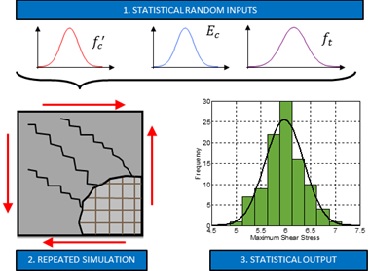
Monte Carlo Simulation Using MCFT
Modelling of Alkali-Aggregate Reaction Effects in Reinforced Concrete Structures
Chemical deterioration of concrete in the form of alkali-aggregate reaction (AAR) is a slow-evolving but progressive process leading to expansion and cracking of concrete. An extensive amount of research has been made since it’s discovery in 1940 due to an increased manifestation of the reaction in major structures such as bridges, dams and nuclear power plants. However, it still represents an important durability issue that causes significant economic damage worldwide. Numerical simulation of AAR effects on concrete plays an important role in determining the behavior of AAR-affected structures. As such, constitutive models for AAR-affected concrete were implemented within the architecture of VecTor2. The AAR expansion was treated as a non-recoverable offset strain using a computational procedure previously developed for elastic and plastic offset strains. Two distinct mechanisms were taken into consideration to fully capture the effects of AAR on concrete: material expansion and the accompanying changes in mechanical properties. Verification studies are being performed at two levels: material-level (cylinders, prisms, and cubes) and structural-level (beams, shear walls) by modelling AAR-affected specimens reported in the literature. The analytically determined responses currently show good agreement with the experimental results. The current accuracy will be improved once conclusions are drawn from the material-level investigation and the structural testing, parts of the study that is currently underway.

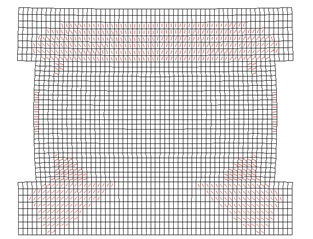
Crack pattern for AAR-affected shear wall
Finite Element Modelling of Corrosion Damaged Reinforced Concrete Structures
Corrosion of steel is the predominant deterioration mechanism of reinforced concrete structures throughout the world. Corrosion can affect the strength and serviceability by reducing the cross-sectional area of reinforcing steel. The degree to which the structural performance is degraded depends on the nature and severity of corrosion and the location of its occurrence. Considering the great number of old and defective reinforced concrete structures that are present within our built environment, there is a considerable need for reliable tools to assess the effects of corrosion on the behaviour of reinforced concrete. One of the tools that can assist in drawing proper conclusions on the state of a corroded reinforced concrete structure is finite element modelling. In light of the current development of numerical models for corrosion damage, this study focuses on implementing corrosion damage constitutive models within the algorithms of VecTor2.


Unifrom and pitting corrosion implemented in VecTor2
Advanced Three-Dimensional Nonlinear Analysis of Reinforced Concrete Structures Subjected to Fire and Extreme Loads
As the mechanical properties of reinforced concrete change significantly at elevated temperatures, and as most of the international building codes are getting more concerned with performance-based design having fire-performance criteria, investigating the behaviour of reinforced concrete structures under elevated temperatures and fire is the major area of Fady ElMohandes’ research. Thermal analysis is being incorporated in VecTor3 software, the part of the VecTor analysis software responsible for the analysis of three-dimensional reinforced concrete solid elements. In addition, dynamic analysis capabilities including blast and impact loading are also being included in the software. For the sake of the corroboration of VecTor3, an intensive experimental program is planned, where various types of elements will be tested with different types of concrete, levels of sustained loading, confinement levels and temperature loading profiles.

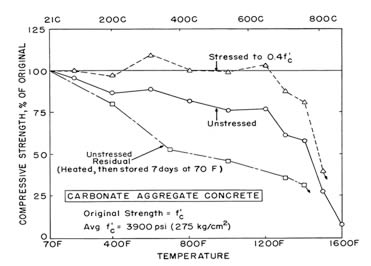
Effect of Temperature on Compression Strength of Carbonate Aggregate Concrete
(Abrams, 1971)
Behaviour and Modelling of Reinforced Concrete Slabs and Shells under Static and Dynamic Loads
There is a growing need for analytical tools which are capable of accurately modelling reinforced concrete (RC) structures under generalized loading conditions. The analytical procedures forming most of the available commercial programs have often been met with limited success as they often require complex and expensive micro-modelling approaches, results are often highly sensitive to user-selected behavioural models and analysis parameters, and many of the programs have demonstrated inabilities in capturing the brittle concrete response of shear-critical elements.
A procedure for improved nonlinear analysis of RC slab and shell structures has been developed and implemented within the framework of the nonlinear finite element program VecTor4. The program employs a layered thick-shell formulation which considers out-of-plane (through-thickness) shear forces, a feature which makes it notably different from most shell analysis programs. Previous versions of the program were of somewhat limited use due to their inabilities to accurately capture out-of-plane shear failures, and because analyses were restricted to monotonic loading conditions. The work performed in this research program was focused on addressing these limitations, and implementing new analysis features extending the range of structures and loading conditions that can be considered. The accuracy of the resulting program was verified using test specimens presented in the literature spanning various member types and loading conditions. The new program features are shown to enhance modelling capabilities and provide accurate assessments of shear-critical structures.
In addition to the analytical study, an experimental program consisting of RC and FRC slab specimens under dynamic loading conditions was performed. Eight intermediate-scale slabs were constructed and tested to failure under sequential high-mass low-velocity impact. The data from the testing program were used to verify the dynamic and FRC modelling procedures developed, and to contribute to a research area which is currently limited within the database of literature: the global response of RC and FRC elements under impact. Test results showed that the addition of end-hooked steel fibres was effective in increasing the capacities of the slabs, reducing crack widths and spacings, and mitigating the development of local damage under repeated impact loading. VecTor4 analyses of the slabs showed that high accuracy estimates can be obtained for RC and FRC elements under impact using basic modelling techniques and simple finite element meshes.
Details regarding the shell structure analysis program VecTor4 and the companion experimental study are presented in Hrynyk (2013). The unfiltered digital data collected during the impact testing program are also provided: Slab Digital Data.

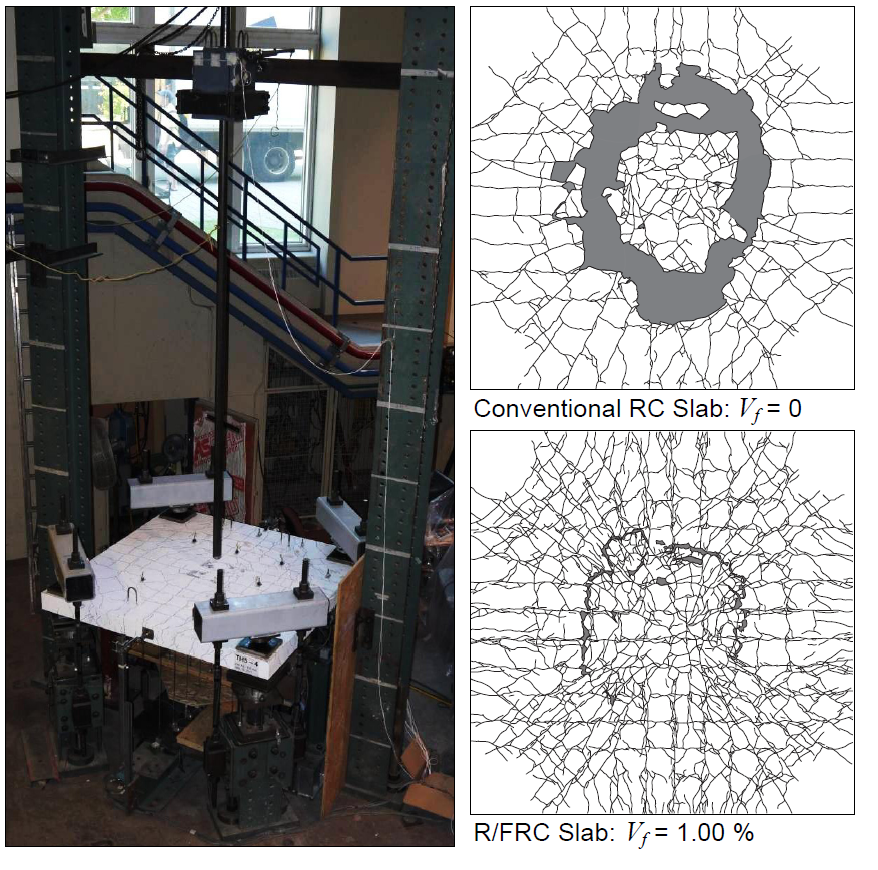
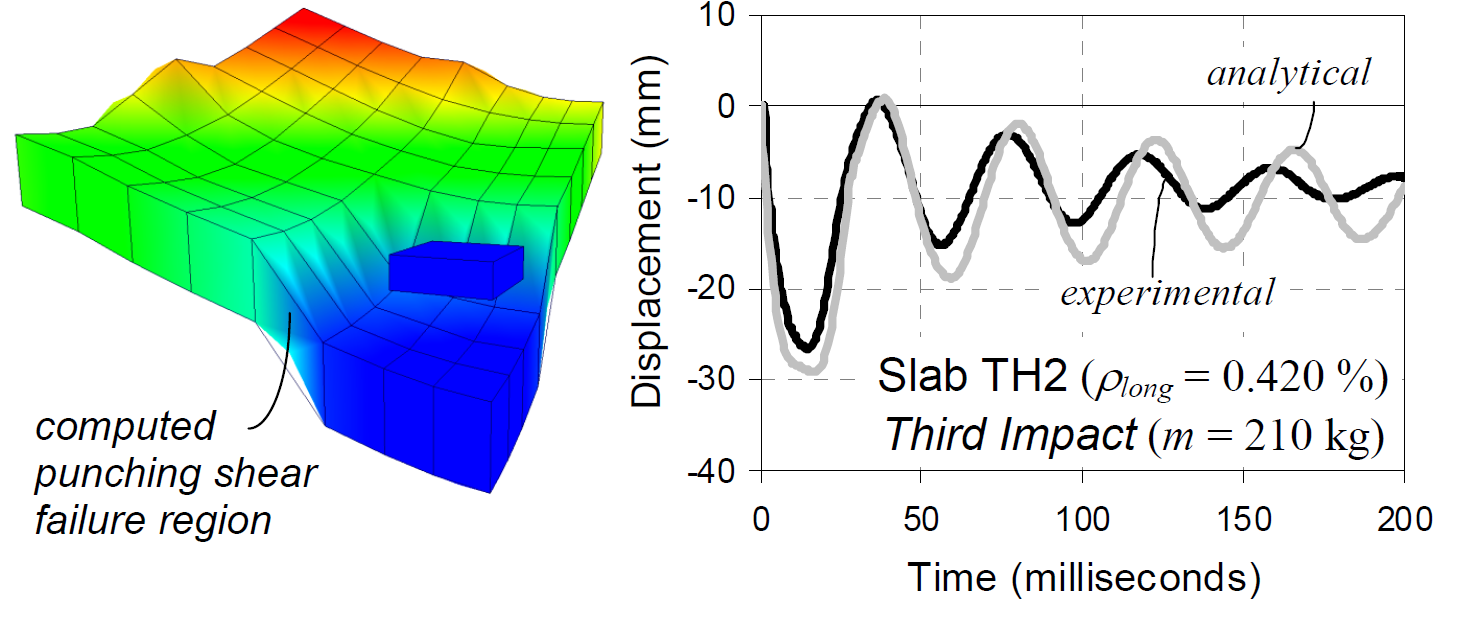
Behaviour of Steel Fibre Reinforced Concrete Under Reversed Cyclic Loading
One of the key benefits from the addition of steel fibres to reinforced concrete is in improving the shear resistance of the structural element; hence, it is important to investigate the behaviour of steel fibre reinforced concrete (SFRC) under pure shear conditions without the obscuring effects of flexure. An experimental test program has been established to accomplish this goal. A series of in-plane panel specimens (890x890x70 mm) will be tested using University of Toronto’s Panel Element Tester, one of the few facilities in the world capable of isolating shear-related mechanisms. The panels will have varying steel fibre volume fractions, fibre lengths and fibre tensile strengths. The loading protocols include monotonic shear and reversed cyclic shear.
Results from this experimental study will be used to improve constitutive models for SFRC. Namely, the goal is to study the effects of the presence of steel fibres and conventional reinforcements on cracking characteristics, post-cracking rotation of principal stresses and principal strains, slip along the crack surface, tension stiffening, tension softening, compression softening and post-peak ductility. Ultimately, the constitutive models developed will be implemented into the VecTor suite of nonlinear finite element analysis programs to allow for more accurate analysis of SFRC structures.
Details regarding the research program is provided in Luo (2014)

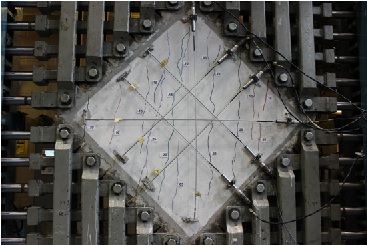
Janus: A Post-Processor for VecTor Analysis Software
Finite element analysis (FEA) programs facilitate the analysis of complex structures which may not be readily designed by traditional means, generating vast arrays of data in approximately predicting the behaviour of a given under a desired loading scenario. Contemporary FEA programs, such as the VecTor software suite, utilize post-processor programs to allow for the multitude of numerical information to be comprehensively displayed graphically for ease of data synthesis, interpretation and verification of results. The proposed Janus post-processor program will be used to augment the existing VecTor structural analysis programs, providing the user with the capability to display both two-dimensional and three-dimensional global structural response characteristics such as: crack patterns, stress contours, deflections, and load patterns. The Janus post-processor will not only allow for the user to comprehensively recall and manipulate structural analysis results on a global scale, but will also have the capacity to display pertinent information for individual specified elements of interest as well.
Details regarding the research program is provided in Chak (2013).

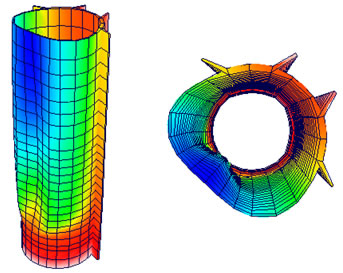
Janus post-processor:
Storage silo displaced shape
Behaviour of Fibre Reinforced Concrete Under Reversed Cyclic Loading
The benefits of fibre reinforced concrete (FRC) have been thoroughly investigated. Much of this work has focussed on steel FRC subjected to monotonic loads. Data on the structural behaviour of macro-synthetic FRC or FRC under cyclic loads is scarce.
A pilot investigation on the shear behaviour of macro-synthetic FRC and on the behaviour of FRC under reversed cyclic in-plane shear loading was carried out. Five in-plane shear panel tests were performed. The parameters under study were the fibre material type (steel or macro-synthetic) and loading protocol. Additionally, a number of compression, direct tension, and flexural tests were performed to determine the material properties of the concretes for comparison. The material response of 2.0% by volume of macro-synthetic FRC matched closely with 1.0% steel FRC.
Finally, building upon an existing steel FRC model, a model for macro-synthetic FRC in tension was proposed and a short verification study was undertaken.
Details regarding the research program is provided in Carnovale (2013)

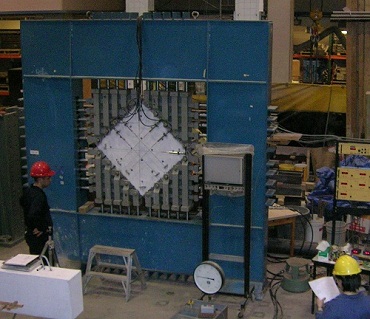
Analysis of Reinforced Concrete Structures Under Blast Loads
The analysis of reinforced concrete structures under blast and impact loads is an area of research that has become increasingly relevant in recent years. Complex hydrocodes are typically used for impact analyses, although single-degree-of-freedom methods have also been developed. There are a number of disadvantages associated withboth methods, and the Canadian Nuclear Safety Commission (CNSC) is looking for a tool thatcan be used in conjunction with hydrocodes to analyze hard and soft missile impacts, with target damage ranging from flexural cracking to perforation.
The VecTor programs, a suite of nonlinear finite element programs developed at the University of Toronto for the analysis of reinforced concrete structures, can potentially be developed into such tools. The analytical work done in this studyserves to investigate the current impact and impulse loading analysis capabilities in VecTor2 and VecTor3, and to identify areas where work should be focused in the future.
The complete details of the research program can be viewed in Trommels (2013).

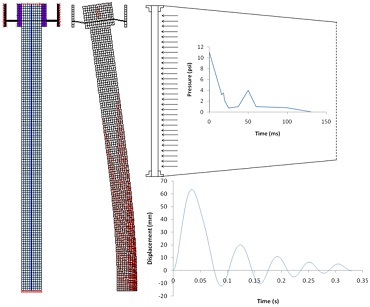
FormWorks-Plus: Improved Pre-Processor for VecTor Analysis Software
The first objective of this study was to develop an updated version of FormWorks, FormWorks 3.8, which is more user-friendly and compatible with newer versions of VecTor2. The second objective was to create a new version of FormWorks, FormWorks-Plus, capable of modeling different types of structures including 2D Membrane Structures, 3D Solid Structures, Shell Structures, Plane Frame Structures, and Axisymmetric Solid Structures.
FormWorks 3.8 was mainly developed to model the different types of materials now available in VecTor2 including Reinforced Concrete, Structural Steel, Masonry, Wood, Concrete-Steel Laminate, Concrete-SFRC Laminate, Masonry-SFRC Laminate, Concrete-Ortho Laminate, Reinforcement, and Bond. In addition, the Job Page was updated with the most recent behavioural models and analysis parameters. The zooming feature of FormWorks was improved to display the geometry of the finite element model properly. A new load type, Nodal Thermal Load, was added to the program allowing the user to define thermal loads for nodes. The performance of the truss and rectangular elements was improved. Finally, updated dialog boxes for nodes, elements, restraints, and load types were added to facilitate the modifying process of finite element model.
FormWorks-Plus is a new version of FormWorks, compatible with entire suite of VecTor programs. In addition to the XY, XZ, and ZY plane views, sectional and projection views were added to the program, greatly contributing to its utility. FormWorks-Plus also uses a supporting program called 3D View which is written with the MFC library and OpenGL (Open Graphics Library), allowing the user to see a 3D view of the structural model. In addition, four different types of node coordinate definitions, five types of elements, several load types, and new material properties are added to the software, making it compatible with the remaining VecTor programs.
The complete details of the research program can be viewed in Sadeghian (2012).

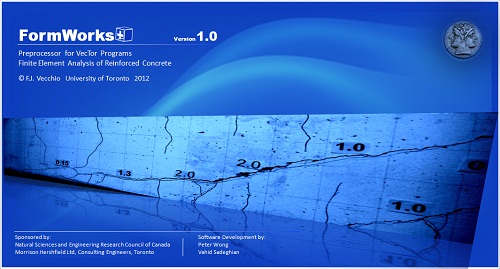
Tensile Behaviour of Fibre Reinforced Concrete
There are many researchers who derived tension stiffening models to evaluate the average tensile stress of concrete. Most of them have focused on tensile behaviour before yielding of reinforcement. After the yielding of reinforcement at the crack surface, the average tensile stress of concrete is reduced because the reinforcement stress is limited to its yield strength (line B-C in Figure). Without this equilibrium check, the capacity of concrete members or structures could be not correct because of an overestimation of concrete tensile stress. With this limitation, after the average strain of reinforcement reaches the yield strain, the average tensile stress of concrete becomes zero. Hence, once the average stresses of reinforcement have reached yield, the contribution of concrete on tensile behaviour is ignored, so the tensile behaviour of reinforced concrete members after yielding of reinforcement becomes the same as that of bare steel bars. Consequently, the equilibrium check on the crack surface makes the ultimate strength and strain identical to those of the bare steel bar (line C-D in Figure). However, tensile stress of concrete still exists even after yielding of reinforcement because of bond behaviour between concrete and steel reinforcement. The contribution of concrete tensile stress after yielding of reinforcement makes the strain at the ultimate condition less than that of the bare steel bar (line C-E in Figure). Therefore, the tensile stress of concrete after the yielding of reinforcement should be considered for a more reasonable and precise prediction of structural behaviour of concrete members and structures.
The main objective of this research is on the development of a tension stiffening model which is applicable to the prediction of the post-yield behaviour of RC members. The model to be developed will be implemented on VecTor2.

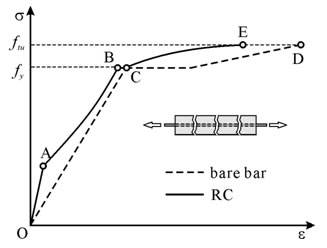
Behaviour of RC members subject to uniaxial tension
Tensile Behaviour of Fibre Reinforced Concrete
Fibres have been used in concrete structures to compensate for the weak point of concrete; its brittle tensile behaviour. One of the most important effects of the application of fibres in concrete structures is that non-brittle behaviour after concrete cracking can be achieved. When evaluating the stress-crack opening displacement response due to fibres, the direct tension specimens tested are generally of a small size. Therefore, the effect of the restriction of fibre orientation should be considered in order to apply test results from small specimens to the analysis of real structures with fibre reinforced concrete. Moreover, some of fibres crossing crack surfaces are engaged in tension while the others are not engaged, so the effectiveness of fibres should be also considered.
The objective of this research is on the derivation of a tensile behaviour model for fibre reinforced concrete which takes account of the member size effect, the effectiveness of the fibres, the fibres' random orientation, and so on, all at once. The model to be derived will be expanded into the derivation of a tension stiffening model for fibre reinforced concrete with ordinary deformed steel reinforcing bars. The model to be derived will be implemented in the VecTor analysis programs.

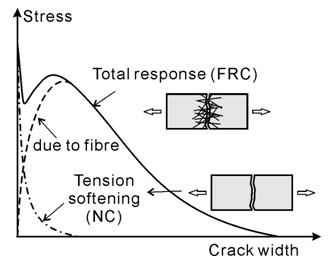
Tensile behaviour of fibre reinforced concrete
Cracking Behaviour of Steel Fibre Reinforced Concrete Containing Conventional Steel Reinforcement
A research program was conducted which focused on improving the ability to model the cracking behaviour of steel fibre reinforced concrete members containing conventional deformed steel reinforcing bars. The objective of this experimental program was to observe the changes in crack widths and spacings caused by the inclusion of steel fibres, as well as to observe the effect of steel fibres on the tensile stress-strain response of reinforced concrete.
The uniaxial tension test specimens had the following dimensions. The specimens were one metre in length, with 250 mm of reinforcing bar protruding from each end for gripping in the testing machine. The square concrete cross section was varied from 50 mm x 50 mm to 200 mm x 200 mm, and the reinforcing bar size was varied from 10M to 30M (Canadian bar sizes). The steel fibre types and volume contents were also varied. Dramix RC-80/30-BP (high-strength 30mm fibres, l/d~80) were used primarily, but the effect of using RL-45/50-BN (normal-strength 50mm fibres, l/d~45) and ZP 305 (normal-strength 30mm fibres, l/d~55) were also investigated. A duplicate of each specimen was produced and tested in order to minimize statistical variance. A total of 60 uniaxial tension tests were performed.
It was observed that crack widths and spacings decreased with increasing fibre content, increasing fibre aspect ratio, increasing conventional reinforcement ratio, and decreasing conventional reinforcing bar diameter. These observations were developed into a stabilized mean crack spacing model which accounts for the influence of steel fibres on cracking behaviour. This model was based on the CEB-FIP 1978 Model Code formulation. This new analytical cracking behaviour model was found to predict stabilized crack spacings with far greater accuracy than those currently available in the literature.The complete details of the research program can be viewed in Deluce (2011).


Uniaxial Tension Test Setup
Fibre Reinforcement for Shrinkage Crack Control in Prestressed, Precast, Segmental Bridges
Extensive work was conducted to investigate the effectiveness of hooked-end steel fibres to control cracks. Seven types of material tests were performed: uniaxial tension test, cylinder compression test, modulus of rupture test, splitting test, free and autogenous shrinkage test, and restrained shrinkage test. In addition, ten 890×890×70 mm concrete panels were tested under in-plane pure-shear loading using the Panel Element Tester. The parameters of study were the fibre volume content (0.5%, 1.0%, and 1.5%), the concrete compressive strength (50 and 80 MPa), and the fibre geometry and tensile strength. In addition to the experimental study, a model was developed to investigate the behaviour of a 1D restrained FRC member subjected to shrinkage.
The experimental results indicated that the addition of fibres significantly improved the behaviour of the concrete, particularly the crack control characteristics, the post-peak compressive response, the post-cracking tensile response, the toughness, and the ductility of the concrete. The results also indicated that steel fibres were as effective as conventional reinforcement in controlling shrinkage cracking, provided that sufficient fibre volume content was added to the concrete. For example, in order to achieve a maximum crack width of 0.35 mm, a minimum fibre content of 0.9% and 1.1% should be provided for 50 MPa FRC containing high aspect ratio fibres and low aspect ratio fibres, respectively. In addition, the results indicated the importance of fibre content and fibre aspect ratio on the effectiveness of fibre reinforcement.


Failure Crack Pattern of Non-FRC Panel
(f’c=50 MPa, rx=3.3%, ry=0.4%)

Failure Crack Pattern of FRC Panel
(f’c=50 MPa, rx=3.3%, 1.5% DRAMIX RC 80/50)
Performance Assessment of Shear-Critical Plane Frames
Although modern design codes typically require concrete frame structures to be designed to be ductile and flexure-critical in their behaviour, many situations arise in practice where shear-related mechanisms play a significant role in the response of structures. Advanced analytical tools that rigorously consider shear behaviour are required for a comprehensive and accurate assessment of the performance of such frames. However, the typical analysis tools currently available either ignore shear mechanisms altogether, employ opaque and overly-simplistic formulations, or are overly-complex requiring the selection of numerous parameters and supporting calculations prior to the analysis. Most neglect shear deformations by default.
A research initiative was undertaken to develop a nonlinear analysis procedure, VecTor5, for plane frames that accurately accounts for shear effects, but one that does not require extensive pre-selection of analysis options, material models and failure modes nor extensive supporting analyses or calculations prior to the analysis. The procedure developed is capable of considering static loads (i.e., monotonic, cyclic and reversed-cyclic) as well as dynamic loads (i.e., base accelerations, impulse, impact and blast forces, initial mass velocities, and constant mass accelerations). The advantage of the procedure lies in its simple modelling, and inherent and accurate consideration of shear effects.Complete details of the formulation, application and verification of the procedure is provided by Guner (2008).

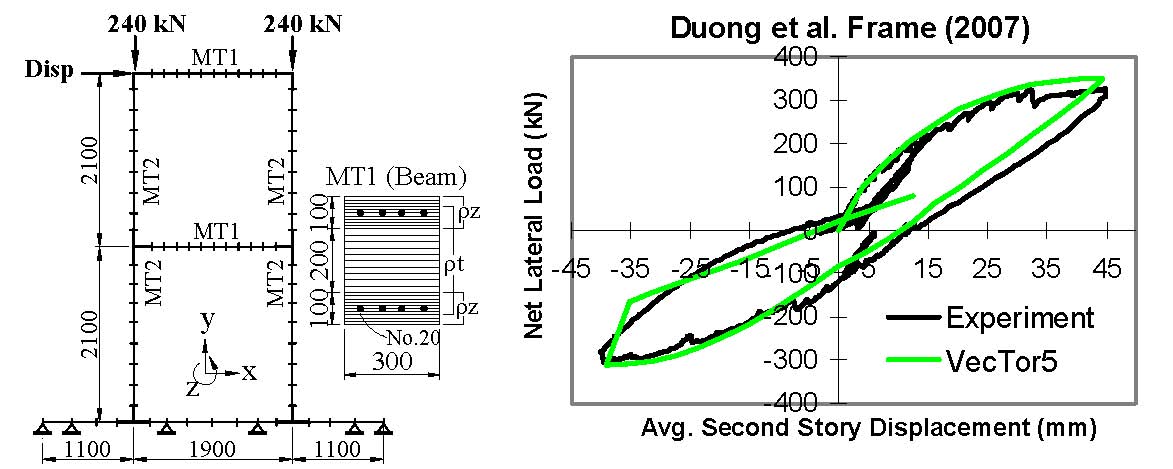
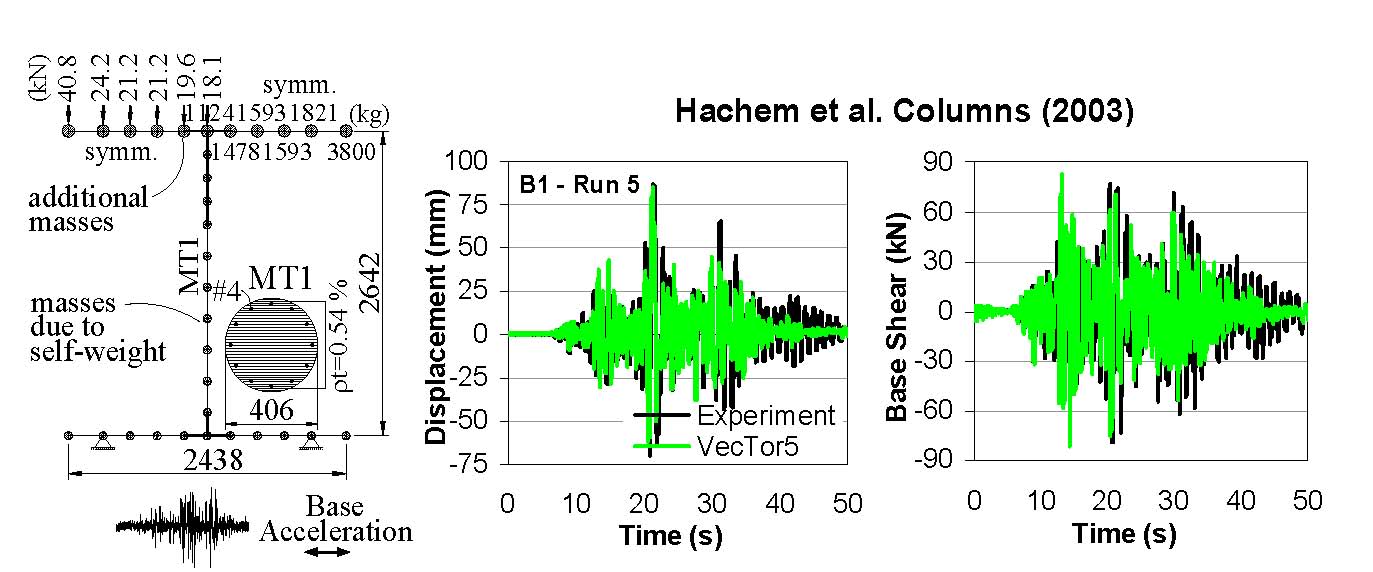
Behaviour and Modelling of Reinforced Concrete Structures Subjected to Impact Loads
The analysis and design of reinforced concrete (RC) structures against extreme loads, such as earthquakes, blasts, and impacts, has been an objective of many researchers and designers. As a result of recently elevated terror threat levels in the world, demand for the impact resistant design of buildings has increased. Numerous studies have been conducted to-date for understanding and developing methodologies predicting the behaviour of RC structures under impact loads. However, lack of complete understanding of shear behaviour under high dynamic conditions hindered the efforts for accurate prediction of impact behaviour, since severe shear mechanisms may dominate the behaviour of RC structures when subjected to impact loads.
This study aimed to apply one of the more successful methods of static reinforced concrete shear analysis, the Modified Compression Field Theory (MCFT), to the analysis of dynamic loads, and thus, develop an efficient and reliable tool for impact analysis of RC structures. Two-dimensional nonlinear finite element analysis program for reinforced concrete, VecTor2, developed previously at the University of Toronto for static loads, was modified to include the consideration of dynamic loads, including impacts. VecTor2 uses the MCFT for its computational methodology, along with a wide array of material and behavioural models for reinforced concrete. To verify the performance of VecTor2 and its computational methodology under impact loads, an experimental program was also undertaken to provide data for corroboration. Eight reinforced concrete beam specimens, four pairs, were tested under free falling drop-weights, impacting the specimens at the mid-span. All specimens had identical longitudinal reinforcement, but varying shear reinforcement ratio, intended to investigate the effects of shear capacity on the impact behaviour. A total of 20 tests were conducted, including multiple tests on each specimen. The test results showed that the shear characteristics of the specimens played an important role in their overall behaviour. All specimens, regardless of their shear capacity, developed severe diagonal shear cracks, forming a shear-plug under the impact point. The VecTor2 analyses of the test specimens were satisfactory in predicting damage levels, and maximum and residual displacements. The methodology employed by VecTor2, based on the MCFT, proved to be successful in predicting the shear-dominant behaviour of the specimens under impact.

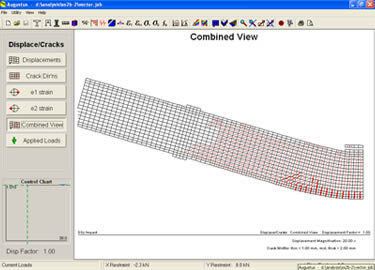
Augustus Screenshot